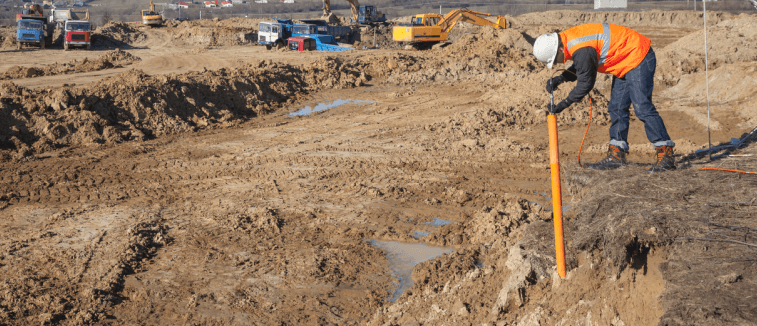Exactly How a Competent Tailings Engineer Can Maximize Your Mining Workflow
Exactly How a Competent Tailings Engineer Can Maximize Your Mining Workflow
Blog Article
Exploring the Ingenious Strategies and Technologies Shaping the Future of the Geotechnical Industry for Sustainable Engineering Solutions
The geotechnical market is undertaking a transformative change, driven by innovative strategies and technologies that stress sustainable engineering solutions. Advanced dirt stablizing approaches, making use of smart materials, and the application of information analytics are redefining exactly how we come close to facilities challenges. As these innovations promote ecological stewardship, they likewise increase essential questions about their practical application and long-lasting efficiency. Recognizing the interaction in between these innovations and their potential to transform the field invites further exploration into the future of sustainable design techniques.
Advanced Dirt Stabilization Strategies
Dirt stabilization is a crucial process in geotechnical design, targeted at improving the physical properties of dirt to enhance its load-bearing capacity and resilience. Advanced soil stabilization techniques play a crucial role in addressing difficulties related to weak or unstable soils, therefore allowing safe and reliable building techniques.
Among the prominent techniques, chemical stabilization entails making use of ingredients such as lime, cement, or fly ash, which respond with dirt fragments to form an extra cohesive mass. This method is particularly efficient in enhancing the strength and wetness resistance of large clay soils. Mechanical stablizing, on the various other hand, includes the physical change of soil properties with compaction or the unification of granular materials, leading to enhanced thickness and security.
Another ingenious approach is the usage of geosynthetics, which provide support and reduce dirt erosion while enhancing drainage. Methods like dirt mixing and deep soil stablizing are likewise gaining grip, enabling in-situ therapy of problematic dirts. Collectively, these innovative approaches not only improve the performance of dirt structures but also contribute to sustainable engineering practices by lessening the demand for extensive excavation and material transportation.
Smart Products in Geotechnics
Advancement goes to the center of geotechnical design, specifically with the unification of clever products that boost the efficiency and capability of dirt structures. Smart materials, such as form memory alloys, piezoelectric products, and self-healing polymers, are changing the means designers come close to dirt stablizing and facilities durability (geo tech engineer). These materials can adjust to transforming environmental conditions, react to stress, and even repair themselves, significantly enhancing the resilience of geotechnical systems
As an example, piezoelectric products can generate electric costs in action to mechanical tension, offering possible for real-time tracking of soil problems and structural integrity. Self-healing products can autonomously repair problems and splits, decreasing upkeep costs and expanding the life-span of geotechnical assets. The assimilation of these smart products not only enhances the mechanical residential properties of soil yet also adds to lasting design practices by lessening resource usage and ecological impact.
As the geotechnical industry remains to advance, the adoption of wise products will certainly play an essential duty in developing ingenious solutions, guaranteeing that facilities are not only durable yet also versatile to future difficulties. This transformative technique is poised to redefine the criteria of security and efficiency in geotechnical engineering.
Information Analytics for Framework
The integration of wise products in geotechnical design has actually paved the method for sophisticated techniques, particularly in the realm of information analytics for infrastructure. This innovative method leverages considerable information collection and logical methods to boost decision-making procedures throughout the framework lifecycle. By making use of sensing units installed in smart products, designers can continuously check important criteria such as soil security, dampness degrees, and architectural honesty.
Data analytics allows the change of raw data into workable insights, allowing for anticipating upkeep and boosted threat monitoring. Advanced algorithms and machine knowing techniques facilitate the recognition of patterns and anomalies, which can educate timely interventions and maximize source appropriation. Furthermore, integrating geographical info systems (GIS) boosts spatial evaluation, further improving the decision-making structure.
By taking advantage of the power of information analytics, the geotechnical market is placed to not just improve current techniques however also pioneer cutting-edge solutions for future framework difficulties. This synergy of modern technology and engineering principles will specify the future of lasting framework development.

Sustainable Ground Enhancement Approaches
Numerous lasting ground improvement techniques are becoming essential remedies to address the challenges of geotechnical design while minimizing environmental impact. These techniques not only improve soil efficiency but also promote ecological stewardship by decreasing dependence on traditional, much more invasive techniques.

One more innovative method is the application of geosynthetics, that includes eco-friendly products that strengthen check it out soil while promoting drainage and disintegration control - geo tech engineer. This decreases the need for hefty equipment and lessens site disruption, therefore preserving neighborhood ecological communities
Additionally, techniques such as vibrant compaction and vibro-replacement have evolved to consist of sustainable techniques, including recycled products and decreasing carbon footprints. These methods exemplify the market's shift towards more environmentally liable options, making sure that ground improvement not just meets engineering needs however additionally contributes favorably to the surrounding environment.
Technologies in Environmental Monitoring
Recently, advancements in environmental surveillance have substantially boosted the capability to analyze and manage check that geotechnical projects with minimal environmental interruption. Innovative innovations, such as remote sensing, Internet of Things (IoT) devices, and real-time information analytics, are changing just how ecological effects are determined and reduced.
Remote noticing modern technologies, consisting of satellite imagery and airborne LiDAR, promote the rapid evaluation of land usage modifications and environmental conditions - tailings engineer. These devices permit continual surveillance of websites, enabling designers to identify prospective problems before they escalate. Additionally, IoT devices, furnished with sensing units for criteria like dirt wetness, gas, and temperature discharges, offer live information streams that boost the understanding of site-specific ecological variables
Real-time data analytics even more refine decision-making procedures by integrating data from numerous resources, enabling for proactive management approaches. This holistic approach not just makes sure compliance with ecological guidelines however likewise promotes lasting methods within the geotechnical industry.
As these innovations proceed to develop, they hold the prospective to bridge the void between design goals and ecological stewardship, promoting a more sustainable future for geotechnical tasks worldwide.
Final Thought
Advanced soil stablizing methods, the combination of smart materials, and the application of data analytics collectively enhance the strength and performance of facilities. These innovations not just address modern design obstacles yet additionally pave the way for a more sustainable future in geotechnical practices.
Methods like soil blending and deep soil stablizing are important link likewise acquiring traction, allowing for in-situ therapy of troublesome soils. Jointly, these advanced approaches not only boost the efficiency of dirt structures yet also add to sustainable design practices by reducing the need for considerable excavation and material transportation.

Report this page